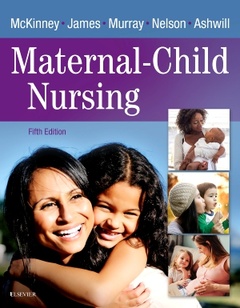Description
Maternal-Child Nursing (5th Ed.)
Authors: McKinney Emily Slone, James Susan R., Murray Sharon Smith, Nelson Kristine, Ashwill Jean
Language: English
Subjects for Maternal-Child Nursing :
Approximative price 130.11 €
In Print (Delivery period: 14 days).
Add to cart1592 p. · 22.2x28.1 cm · Hardback
Description
/li>Contents
/li>Biography
/li>
Easily master maternity and pediatric nursing care with Maternal-Child Nursing, 5th Edition. This easy-to-read text is filled with a wealth of user-friendly features to help you quickly master essential concepts and skills. It offers completely updated content - including expanded information on the late preterm infant, fetal heart rate pattern identification, obesity in the pregnant woman and children, and enhanced coverage of the QSEN initiative. It also features an abundance of active learning tools so you have ample opportunities to practice applying your knowledge and skills.
. 1. Foundations of Maternity, Women's Health, and Child Health Nursing
. 2. The Nurse's Role in Maternity, Women's Health, and Pediatric Nursing
. 3. The Childbearing and Child-Rearing Family
. 4. Communicating with Children and Families
. 5. Health Promotion for the Developing Child
. 6. Health Promotion for the Infant
. 7. Health Promotion During Early Childhood
. 8. Health Promotion for the School-Age Child
. 9. Health Promotion for the Adolescent
. 10. Heredity and Environmental Influences on Development
Maternity nursing care
. 11. Reproductive Anatomy and Physiology
. 12. Conception and Prenatal Development
. 13. Adaptations to Pregnancy
. 14. Nutrition for Childbearing
. 15. Prenatal Diagnostic Tests
. 16. Giving Birth
. 17. Intrapartum Fetal Surveillance
. 18. Pain Management for Childbirth
. 19. Nursing Care During Obstetric Procedures
. 20. Postpartum Adaptations
. 21. The Normal Newborn: Adaptation and Assessment
. 22. The Normal Newborn: Nursing Care
. 23. Newborn Feeding
. 24. The Childbearing Family with Special Needs
. 25. Pregnancy-Related Complications
. 26. Concurrent Disorders During Pregnancy
. 27. The Woman with an Intrapartum Complication
. 28. The Woman with a Postpartum Complication
. 29. The High-Risk Newborn: Problems Related to Gestational Age and Development
. 30. The High-Risk Newborn: Acquired and Congenital Conditions
. 31. Management of Fertility and Infertility
. 32. Women's Health Care
Pediatric nursing care
. 33. Physical Assessment of Children
. 34. Emergency Care of the Child
. 35. The III Child in the Hospital and Other Care Settings
. 36. The Child with a Chronic Condition or Terminal Illness
. 37. Principles and Procedures for Nursing Care of Children
. 38. Medication Administration and Safety for Infants and Children
. 39. Pain Management for Children
. 40. The Child with a Fluid and Electrolyte Alteration
. 41. The Child with an Infectious Disease
. 42. The Child with an Immunologic Alteration
. 43. The Child with a Gastrointestinal Alteration
. 44. The Child with a Genitourinary Alteration
. 45. The Child with a Respiratory Alteration
. 46. The Child with a Cardiovascular Alteration
. 47. The Child with a Hematologic Alteration
. 48. The Child with Cancer
. 49. The Child with an Alteration in Tissue Integrity
. 50. The Child with a Musculoskeletal Alteration
. 51. The Child with an Endocrine or Metabolic Alteration
. 52. The Child with a Neurologic Alteration
. 53. Psychosocial Problems in Children and Families
. 54. The Child with a Developmental Disability
. 55. The Child with a Sensory Alteration
. Glossary
Baylor Healthcare System, Dallas, TX




